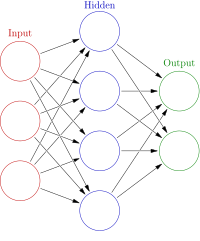
Photo from wikipedia
Abstract In this paper, a novel method is presented for detecting anomalies in ocean fixed-point observing time series, which combines wavelet neural network (WNN), classifying threshold and two detecting strategies.… Click to show full abstract
Abstract In this paper, a novel method is presented for detecting anomalies in ocean fixed-point observing time series, which combines wavelet neural network (WNN), classifying threshold and two detecting strategies. The WNN was developed without any labeled training data to simulate the non-anomalous behaviors for next-step prediction. The classifying threshold was constructed according to the estimated distribution of long-term historical residual errors. The observation strategy (OS) and prediction strategy (PS) were designed to detect new unknown anomalies. Two types of marine observing time series from a buoy, deployed at the National Ocean Test Site of China, were selected for verifying the method. The results show that 99% of classifying confidence level is adequate to provide a reasonable trade-off between the false negative and false positive. By using the two detecting strategies and selecting proper estimated distribution of the threshold, the method is efficient for identifying the anomalous points and patterns which were caused by the natural factors or equipment failures. Compared with traditional ANN and wavelet-ANN, the WNN-based method is more tolerant to noise and more sensitive to anomalies with temporal dependencies. Furthermore, this approach introduced here can work in a real-time way and will help ocean engineering managers to obtain informed decisions.
Journal Title: Ocean Engineering
Year Published: 2019
Link to full text (if available)
Share on Social Media: Sign Up to like & get
recommendations!